




Breathing and Exchange of Gases
This document contains all related materials on the chapter named Breathing and Exchange of Gases as per the NEET syllabus for Biology. It will be fruitful for NEET aspirants who are looking for last-minute revision notes.
The following document carries all of the important concepts and provides insight into the exam pattern. By going through this document and also solving the problems given in it, one will be able to find out all the answers to the important questions related to the chapter such as what are respiratory organs, how do the exchanges of gases take place, what is the oxygen dissociation curve and what are respiratory disorders associated with the respiratory system?
Important Topics of Breathing and Exchange of Gases
Respiratory Organs
Mechanism of Breathing
Exchange of Gases
Transport of Gases
Disorders of Respiratory System
Important Concepts
Respiration vs Breathing
Respiratory Organs
The following table describes the various respiratory organs in different organisms:
Human Respiratory System
It is a network of tissues and organs that help the living organism to breathe. The human respiratory system consists of various organs such as the nose, nasal cavity, pharynx, larynx, trachea, lungs, etc.
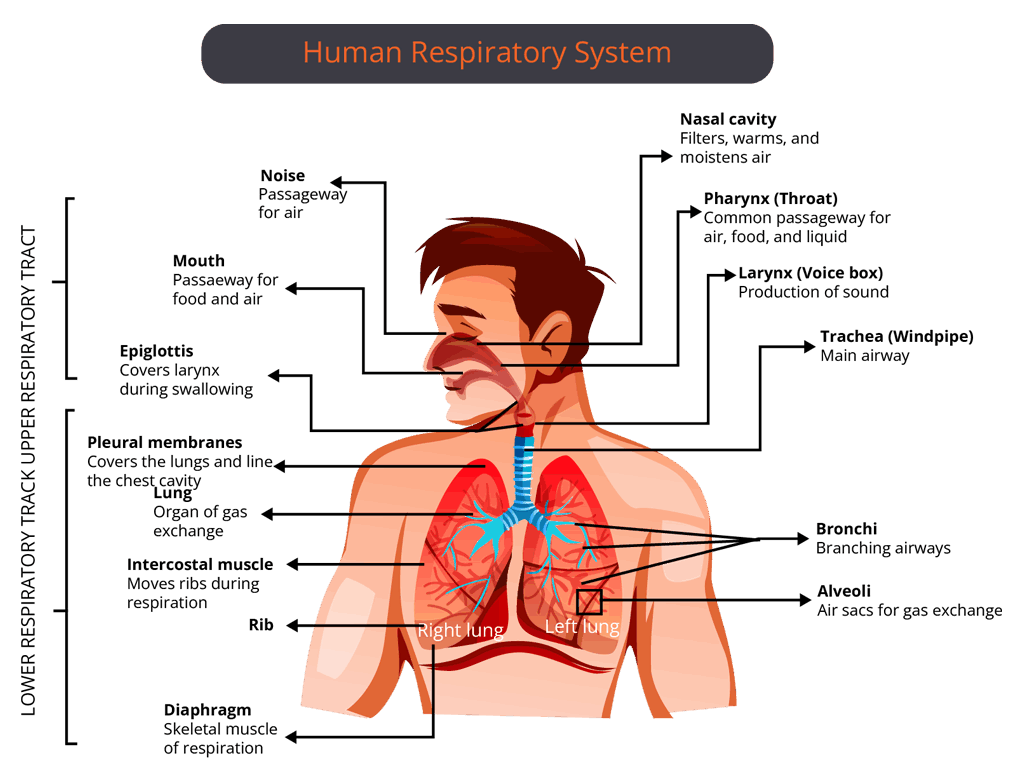
Respiratory System
It is divided into two parts:
The Conduction Part: It is composed of all of the structures that provide passageways for air to travel into and out of the lungs. It includes the nasal cavity, pharynx, trachea, bronchi and mostly bronchioles.
The Exchange Part: It is the site where the diffusion of carbon dioxide and oxygen between blood and atmospheric air takes place.
Mechanism of Breathing
It is defined as the exchange of gases. There are mainly two events that occur during this process.
Inspiration: It is defined as the process which involves the intake of oxygen.
Expiration: It is defined as the process which involves the elimination of carbon-dioxide.
The muscles and their movement during these events are given below:
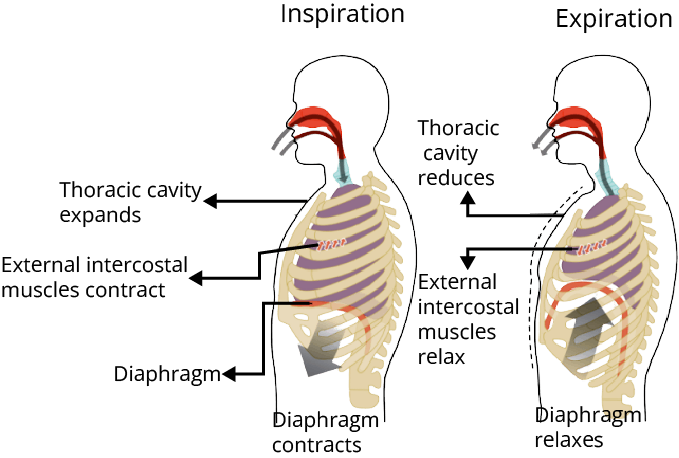
Respiratory Volume and Capacities
Tidal volume: It is defined as the amount of air coming in and going outside the lungs during the normal breathing cycle. Its value is 500ml.
Inspiratory reserve volume: It is defined as the maximum amount of air a person can intake after a normal inspiration. Its value is 2500 to 3000 mL.
Expiratory reserve volume: It is defined as the maximum amount of air a person can exhale after normal expiration. Its value is 1000 to 1100 mL.
Residual volume: It is defined as the amount of air left in the lungs after forceful expiration. Its value is 1100 mL to 1200 mL.
Functional Residual Capacity: It is defined as the volume of air that will remain in the lungs after a normal expiration. It can be calculated by ERV+RV.
Inspiratory capacity: It is defined as the maximum volume of air that can be inspired after reaching the end of a normal, quiet expiration. It can be calculated by TV+IRV.
Expiratory capacity: After normal inspiration, the total volume of air a person can expire is known as expiratory capacity. It can be calculated by TV+ERV.
Vital capacity: It is defined as the amount of air a person can expel out of the lung after a maximum inspiration (intake of oxygen into the lungs). It can be calculated by TV+IRV+ERV.
Total lung capacity: At the end of forceful inspiration, the total volume of air accommodated in the lungs is called the total lung capacity. It can be calculated by VC+RV.
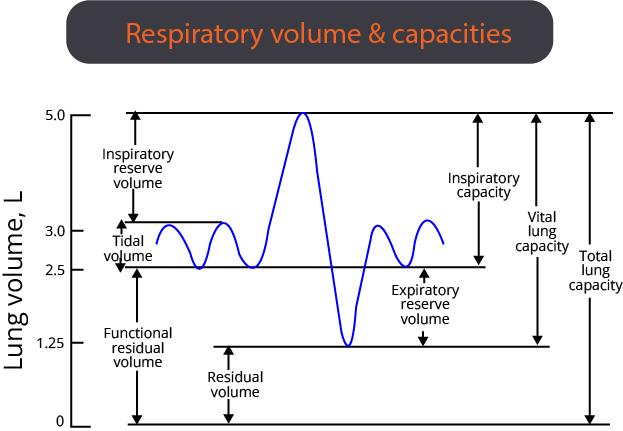
Exchange of Gases
Alveoli is the main site for the exchange of gases. It takes place via diffusion, which is a process that involves the movement of molecules (gas molecules in case of breathing) from higher concentration to lower concentration or higher partial pressure to lower partial pressure. The process of breathing is based upon this principle only.
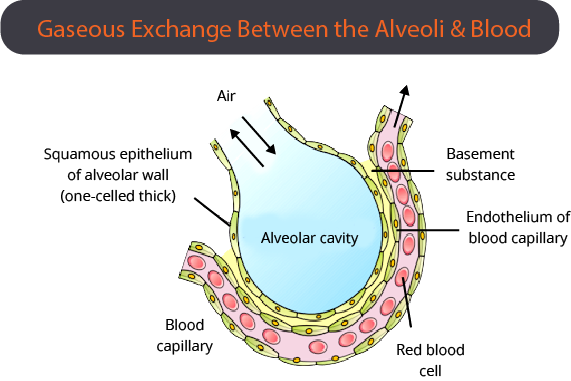
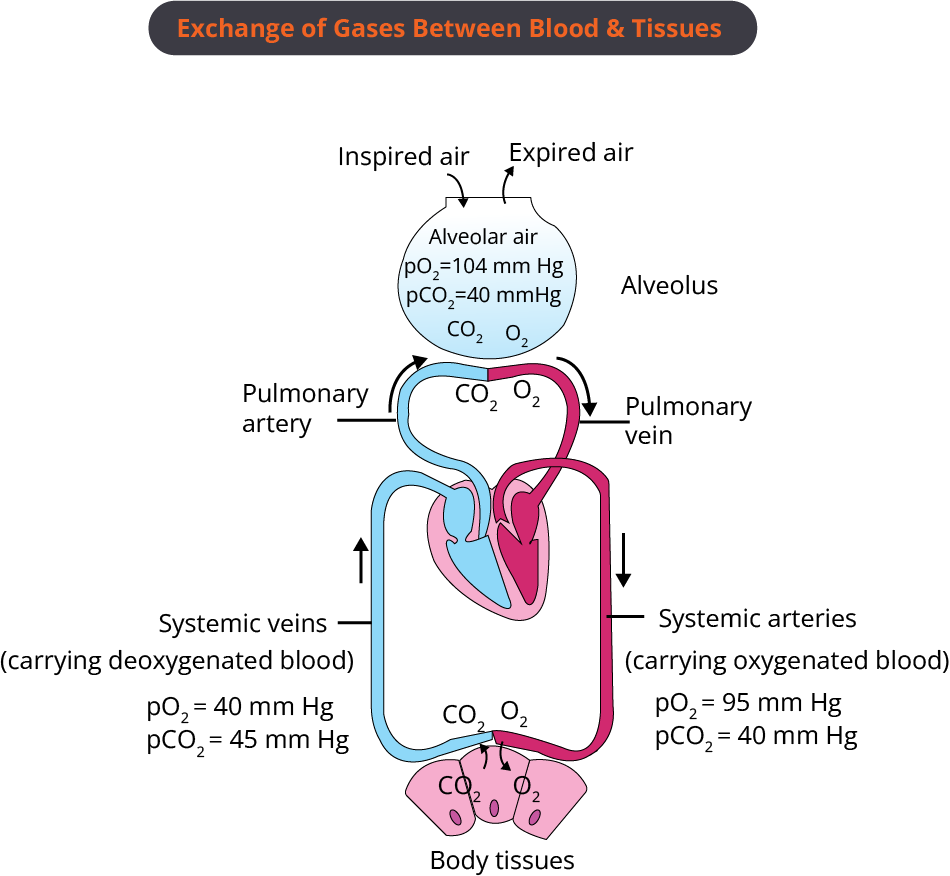
Transport of Gases
The transport of gases (oxygen and carbon dioxide) is done via the blood which is a fluid connective tissue.
Oxygen-transport: Approximately 97% of oxygen is transported by RBCs in the blood. The remaining (3%) amount of oxygen is carried in a dissolved state through the plasma.
The binding of oxygen with the haemoglobin (respiratory pigment) is associated with certain factors, such as partial pressure of oxygen and carbon dioxide, hydrogen ions concentration and temperature.
The graph in which the percentage saturation of haemoglobin is plotted against the partial pressure of oxygen is called the oxygen dissociation curve.
The curve is sigmoid in nature.
This curve is mainly used to study the effect of various factors on the binding of oxygen with the haemoglobin.
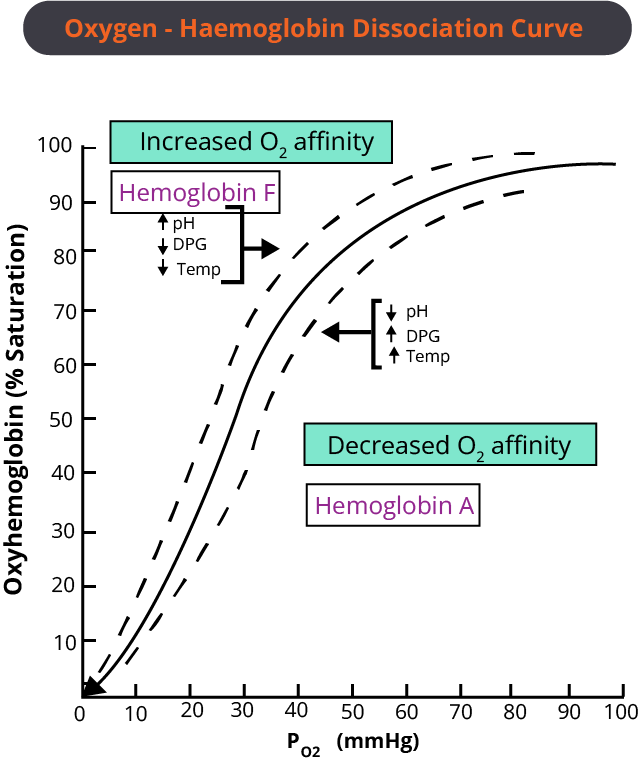
Carbon-dioxide transport Approximately 20-25% of carbon dioxide is transported by RBCs, whereas 70% of it is carried as bicarbonate. Nearly 7 % of carbon dioxide is carried in a dissolved state through plasma.
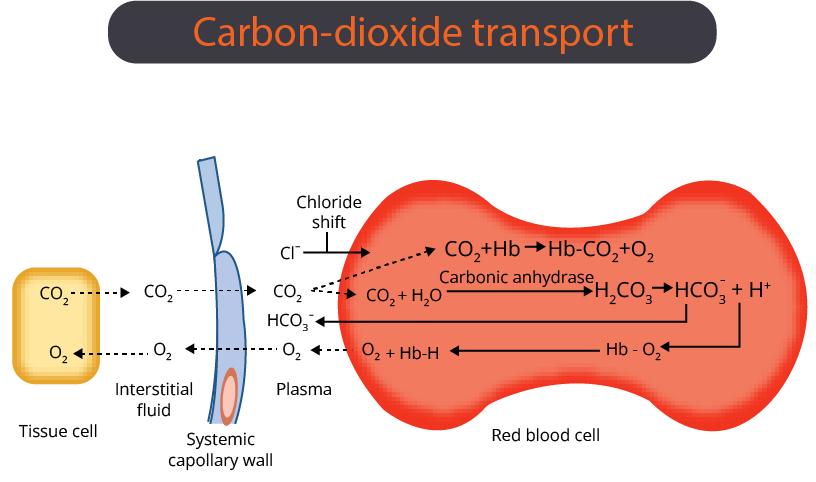
Disorders of the Respiratory System
The following table describes the disorders associated with the respiratory system:
Solved Examples from the Chapter
1. The oxygen-haemoglobin dissociation curve shows the right shift in case of high
High pCO2
High pO2
Low pCO2
Less H+ concentration
Ans: The correct answer is “A”.
The right shift in the oxygen dissociation curve is related to the dissociation of oxyhaemoglobin which occurs when there is low pO2, high pCO2, high H+ concentration and higher temperature exists in the alveoli.
Key point to remember- Right shift = oxyhaemoglobin dissociation
2. What is vital capacity? Describe its significance.
Ans: Vital capacity is defined as the amount of air a person can expel out of the lung after a maximum inspiration(intake of oxygen into the lungs). The value of VC in an average adult human is 3-5 litres. The formula for the vital capacity is VC - TV+IRV+ERV.
It increases the intake of fresh air to its maximum possible amount as well as helps in getting rid of foul air that is full of carbon dioxide in a single stroke. Hence, it increases the amount of gaseous exchange.
As we know, the greater the amount of oxygen, the greater will be the oxidation of respiratory substrate which in turn provides the greater ATP which in the end results in an energetic organism.
Key point to remember VC= TV+IRV+ERV
3. What is chloride shift?
Ans: During the transport of carbon dioxide, the bicarbonate content in RBC becomes much higher in comparison to the plasma (fluid component of blood). The movement of bicarbonate ions from RBC to plasma disturbs the ionic balance, which is restored by chloride ions that diffuse from plasma to the RBC. This movement of chloride ions to restore the ionic balance is called chloride shift or Hamburger’s phenomenon.
Key point to remember: Movement of chloride ions takes place to restore the ionic balance.
Solved Problems of Previous Year Questions
1. Although much CO2 is carried in blood, yet blood does not become acidic, because
It is absorbed by leukocytes
Blood buffer play an important role in carbon-dioxide transport
It combines with water to form H2CO3 which is neutralised by Na2CO3.
It is continuously diffused through tissues & is not allowed to accumulate.
Ans: The correct answer is “B”.
pH is defined as the concentration of H+ ions. The scale that is used to measure the pH is called the pH scale. The pH of blood is 7.4.
The main buffering system present in the blood is bicarbonate (which is formed during CO2 transport in the blood). It exists in equilibrium with carbonic acid which in turn can be converted to CO2 and water.
Tricks to solve easily: Buffering system in the blood maintain an ideal pH of the blood.
2. Name the chronic respiratory disorder caused mainly by cigarette smoking
Respiratory Alkalosis
Respiratory Acidosis
Asthma
Emphysema
Ans: The correct answer is “D”.
Emphysema is a chronic respiratory disorder. During this disorder, there is damage
caused to the alveolar walls due to which the respiratory surface is greatly reduced.
In this disease, exhalation becomes very difficult. There is no cure for this disease
because there is irreversible distension and loss of elasticity of the alveoli of the
lungs.
Tricks to solve Cigarette smoking easily leads to emphysema.
3. Lungs are made up of air-filled sacs, the alveoli. They do not collapse even after forceful expiration, because of :
Residual Volume
Inspiratory Reserve Volume
Tidal Volume
Expiratory Reserve Volume
Ans: The correct answer is “A”.
Residual Volume (RV) is defined as the volume of air remaining inside the lungs even after a forcible expiration. This is the main reason why alveoli do not collapse even after
forceful expiration.
Tricks to solve easily: RR, where first R= residual volume and second R= Remaining air in the lungs.
Practice Questions
1. Find out the incorrect statement related to allergies
Allergy causing agents are known as allergens
The use of drugs like antihistamine, adrenaline and steroids quickly reduces symptoms.
IgE antibody is related to allergy
During allergy there is dilation of bronchioles causing difficulty in breathing.
Ans: The correct answer is “D”.
During allergies such as asthma, there is the constriction of bronchioles that decreases the flow of air in the airways which results in difficulty in breathing. Allergy is defined as the hypersensitivity of any individual to certain foreign particles such as drugs, pollens etc. which are called allergens.
Symptoms include itching, running nose, watery eyes, difficulty in breathing etc. It
involves certain kinds of chemicals such as histamine, serotonin and antibodies such as
IgE. Some forms of the allergy include hayfever, asthma etc. The use of certain kinds of drugs such as antihistamines, steroids etc. quickly reduces the symptoms.
2. What are the characteristics of the respiratory surface?
Ans: A respiratory surface is defined as the area where the exchange of gas takes place. It includes lungs, gills, trachea, etc. The characteristics feature of respiratory surface are as follows:
It must have a large surface area.
It must be thin so that it can make direct contact with the blood capillaries.
It must be moist.
All the characteristics that are described above are responsible for making the process of exchange of gases(carbon dioxide and oxygen) smooth and efficient.
Conclusion
This article contains all important information as per the requirement of students who are preparing for the NEET and can be really helpful for a quick and effective revision. It includes all the important concepts and topics from Biology NCERT books, and questions from previous years’ NEET exam NEET mock test as well.
Make sure to try the practice question on your own to test your knowledge and to get desired outputs.
NEET Important Chapter - Breathing and Exchange of Gases

 Share
ShareFAQs on NEET Important Chapter - Breathing and Exchange of Gases
1. In the Neet exam how many questions were asked from the chapter Breathing and Exchange of Gases?
This particular chapter belongs to the unit human physiology. On average 2-3 questions have been asked from this chapter in the last few years.
2. What is the weightage of the chapter Breathing and Exchange of Gases?
The weightage of this chapter is around 2% according to the analysis of the last 8 years of the NEET exam.
3. What are the important topics of the chapter Breathing and Exchange of Gases?
Although it is one of the most important chapters in terms of the NEET exam, some of the important topics from where the questions are generally asked are the mechanism of breathing, respiratory volume and capacities, transport and exchange of gases, respiratory disorders, etc.








 Watch Video
Watch Video
